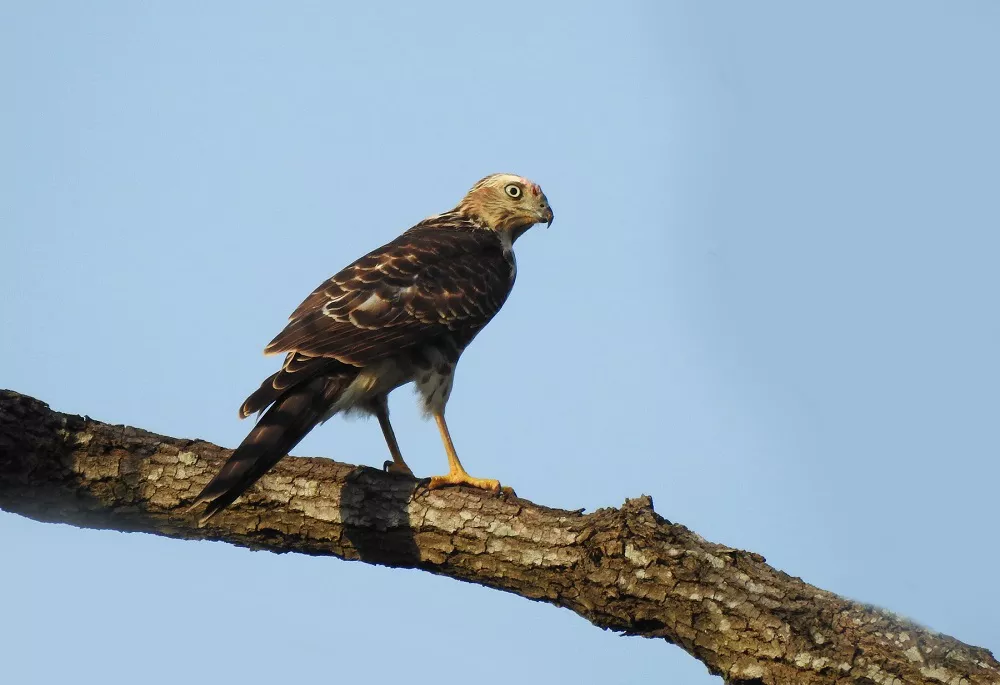The Shikra bird (Accipiter badius) is a fascinating small raptor species that belongs to the Accipitridae family. Known for its agility, sharp hunting skills, and distinctive appearance, the Shikra is a captivating bird that inhabits various regions of South Asia. In this article, we will delve into the key characteristics, habitat, behavior, and conservation status of the Shikra bird, shedding light on its significance in the avian world.
Physical Characteristics:
The Shikra bird exhibits unique features that make it easily recognizable:
Size: The Shikra is a small to medium-sized raptor, measuring approximately 25-30 centimeters (10-12 inches) in length, with a wingspan of 50-60 centimeters (20-24 inches). Females are larger than males.
Plumage: Adult Shikras have a slate-gray to bluish-gray upper body, while their underparts showcase a distinctive orange-brown or rufous coloration with fine white barring. They have short, rounded wings and a long, narrow tail.
Distribution and Habitat:
The Shikra bird is primarily found in South Asia, including countries such as India, Sri Lanka, Bangladesh, Nepal, and parts of Southeast Asia. It inhabits a wide range of habitats, including forests, woodlands, scrublands, urban areas, and even agricultural landscapes. It is adaptable and can thrive in both rural and urban environments.
Hunting Behavior:
Stealthy Approach: Shikras are known for their stealthy hunting techniques. They perch on tree branches, maintaining a keen watch for potential prey. With sudden bursts of speed, they launch themselves into flight to surprise their prey, which mainly consists of small birds and insects.
Agile Flight: The Shikra’s swift and maneuverable flight allows it to navigate through dense vegetation and perform acrobatic aerial maneuvers while pursuing prey.
Breeding and Conservation:
Breeding Behavior: Shikras form monogamous pairs during the breeding season, which typically occurs from December to June. They build nests using twigs and branches, often situated high in trees. The female lays a clutch of 2-5 eggs, which are incubated by both parents for approximately 28-30 days.
Conservation Status: The Shikra bird is categorized as a species of “Least Concern” on the IUCN Red List. However, habitat loss, deforestation, and the use of pesticides in agricultural areas pose potential threats to their populations. Conservation efforts aim to protect their natural habitats, promote sustainable land use practices, and raise awareness about the importance of raptor conservation.
Ecological Significance:
Natural Pest Control: Shikras play a crucial role in controlling populations of small birds and insects, acting as natural predators and helping to maintain ecological balance within their habitats.
Indicator Species: The presence or absence of Shikra birds can serve as an indicator of the overall health and biodiversity of their habitat. Their presence signifies the availability of suitable prey and a balanced ecosystem.
Conclusion:
The Shikra bird, with its agile flight, distinctive plumage, and remarkable hunting skills, is an intriguing raptor species found in South Asia. As we appreciate its unique characteristics and ecological role, it reminds us of the diverse avian species that inhabit our planet. By understanding and conserving the habitats that support the Shikra’s population, we contribute to the preservation of biodiversity and the ecological balance of our natural world.


 Facebook
Facebook  Instagram
Instagram  Youtube
Youtube 